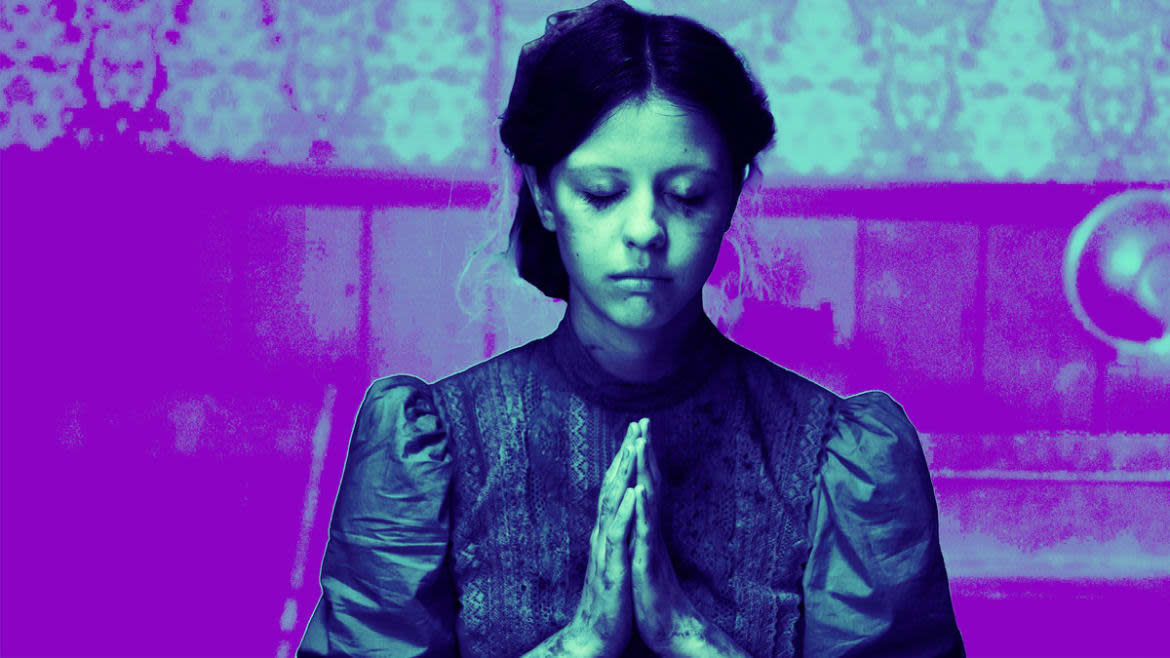‘Pearl’ Is a Masterful Performance Wrapped in a Mediocre Movie

Toward the end of Ti West’s World War I-era X prequel, Pearl, Mia Goth sobs her way through a five-minute monologue designed, more than anything, to blow audiences’ faces off. There are some seriously disturbing confessions, there are tears and snot, and there is catharsis—at least, for Goth’s menacing character. For the horrified person on the other side of the table, not so much.
Goth’s drawn-out monologue crystallizes just how deluded Pearl’s titular villain really is—a climax that should be haunting and hilarious all at once. All of the ingredients are there; Goth’s delivery is compelling and frantic, and the camera fixes on her face with impressive intensity. And yet, something is missing—a sense of urgency, or substance, or both. The speech, like the film that contains it, starts to drag at a certain point. There’s a mustiness to it.
We first met Pearl, the murderous lady of the hour, earlier this year in X—a slasher set during the ’70s grindhouse boom and modeled after the genre classics of the day. In that film, an elderly Pearl and her husband, Howard, terrorize a group of young would-be adult film stars who’ve rented their barn to shoot a porno. Pearl, premiering Friday, introduces the character as a young woman in 1918. Goth, who starred as both Pearl and the final girl Maxine in X, returns not only as Pearl, but also, this time, behind the camera as a screenwriter.
As we discover in Pearl, Pearl’s favorite hobbies as a young woman were not too different from those she’d embrace in her elder years—she’s apparently been killing animals, at least, since she was a little girl. In 1918, her chief activities include tending to a giant, people-chomping alligator (an obvious X tie-in); fighting with her repressive German immigrant mother, Ruth (Tandi Wright); sneaking in trips to the movies (where she steals sips of her sick father’s morphine); and making out with scarecrows in corn fields as she waits for her husband to come back from war.

But Pearl also has a larger-than-life dream: She wants to escape her hum-drum life to become a dancer in the movies. So she practices in front of her farm animals, all of whom are named for famous film stars. There’s something classic about Goth’s wide, tooth grin and starry eyes; her character feels right at home in this gorgeously shot film, which steeps its visuals in classic Americana.
It’s hard to overstate the importance of Goth’s performance in this film, which sees the Suspiria actress tap dancing along a knife’s edge; she’s traumatized by the ongoing war, her husband’s absence, the tremendous responsibilities of caring for her father, and a pandemic that’s got everyone in the town square masked and coughing. (Spanish flu—time is a flat circle.) At once charismatic and repulsive, Goth captures the trapped-rat feeling of desperation that can set in after prolonged trauma. When Pearl goes wide-eyed and gushes about her dreams of stardom, her desire for an escape—any escape—is practically contagious.
Mia Goth and Ti West Spill on ‘Pearl,’ the Most Brutally Ambitious Villain of the Year
While X explored the parallels between porn and horror’s devotion to voyeurism and spectacle, Pearl widens its gaze to examine Hollywood’s place in America’s dreams. Pearl transmutes her anger at her circumstances into a feverish need to become a star—and in so doing, she sets herself up for perpetual disappointment. Ruth, whose sacrifices coming to the U.S. were innumerable, is disgusted by her daughter’s entitlement. Pearl is unable to see that her dreams of becoming a star might not be a divine calling, but instead a sign of deep unhappiness.
Dreams can be both precious and fragile, and more than anything, Pearl seems fascinated with how Hollywood embedded itself in moviegoers’ minds as a Platonic ideal—as a gorgeous but highly exclusive escape from the untenable realities of American life.

Much like its predecessor, however, Pearl can, at times, feel like it was likely better in context than in execution. Goth’s performance, though remarkable, feels like conspicuously fussy window dressing intended to hide a deeper problem: There’s really very little plot here, and not enough ideas at play to run on theme and vibes alone. X was so eager to elaborate on the slasher genre that at times, it failed to actually be a successful slasher; Pearl, meanwhile, simply lacks focus.
As brilliant as the idea might’ve been to film these projects back to back (to back, once we include the upcoming X sequel MaXXXine), Pearl underscores what a cynic might’ve said from the start: At the end of the day, a prequel is still a prequel no matter how you market it—and at the end of the day, you don’t often need a prequel.
Get the Daily Beast's biggest scoops and scandals delivered right to your inbox. Sign up now.
Stay informed and gain unlimited access to the Daily Beast's unmatched reporting. Subscribe now.

 Yahoo News
Yahoo News 
